Three beachgoers interrupt a game of catch to build a sand castle on a busy sandy stretch, so they don’t notice what young readers will see: Their big yellow ball is carried away on the tide to begin a long journey out to sea. Bang's dazzling full-color pastel paintings tell most of the story as they trace the progress of the ball, over dolphins and under sea gulls, beyond a bridge and through a night storm, before being washed ashore on a different beach and into the open arms of another child. Perspectives change but the bright yellow ball is always visible, even when it’s just a dot on the dark blue ocean. This toddler favorite has been out of print so it’s wonderful to see that a 25th anniversary edition will be available in January 2016. --Horning
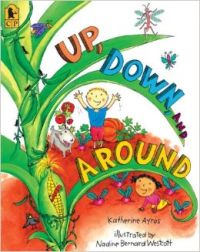 UP, DOWN, AND AROUND, by Katherine Ayers and Nadine Bernard Westcott (Ages 2-4)
UP, DOWN, AND AROUND, by Katherine Ayers and Nadine Bernard Westcott (Ages 2-4)
Two preschool-age children are busy in the garden in a breezy picture book that highlights the concepts of “up,” “down,” and “around.” Digging, planting and watering quickly give way to the garden’s bounty: “Corn grows up. Carrots grow down. Cucumbers climb around and around.” The playful narrative is complemented by Nadine Bernard Westcott’s bright, whimsical illustrations depicting a host of mouthwatering vegetables and a plethora of wiggly, wide-eyed garden creatures, offering lots for children and parents to talk about as they look at the illustrations. --Horning
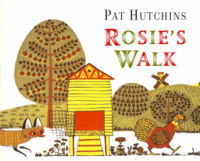 ROSIE’S WALK, Pat Hutchins Macmillan (Ages 2-5)
ROSIE’S WALK, Pat Hutchins Macmillan (Ages 2-5)
It’s easy to see why "Rosie’s Walk" has been a favorite with young children for almost 50 years. The story follows a hen and a fox around a barnyard. Rosie walks around the pond, over the haystack and past the mill -- completely oblivious to the fox who’s pursuing her and the humorous setbacks he faces on each page. The understated text uses directional words to describe Rosie’s journey. --Horning
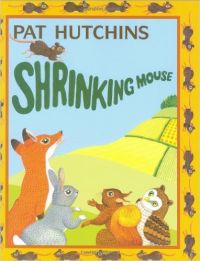 SHRINKING MOUSE, Pat Hutchins (Ages 2-6)
SHRINKING MOUSE, Pat Hutchins (Ages 2-6)
Fox, Rabbit, Squirrel, and Mouse notice that their friend Owl gets smaller and smaller as he flies away from them, and they logically conclude that he is shrinking. One by one, the animals set off in pursuit and the same thing happens each time -- and then they grow bigger when they return. Even if toddlers don't understand the complexity of the spatial perception, there will be much for them to enjoy in the story, while older children will find humor in the animals' misunderstanding of a concept they themselves have only just mastered. --Horning
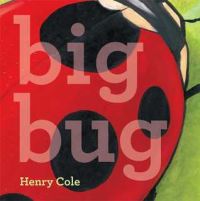 BIG BUG, by Henry Cole (Ages 2-6)
BIG BUG, by Henry Cole (Ages 2-6)
Size is a matter of relativity in this deceptively simple, striking picture book. The opening spread features a ladybug so large it doesn’t quite fit on the two pages. On the next page, we see the ladybug is now small in relation to the big leaf on which it sits. Every turn of the page continues to zoom out to show that what was large is now small in comparison to a newly introduced object. Once we get to the big sky with an aerial view of a farm, the comparisons reverse course, moving in closer on details of the farm. The minimal text will invite parents and children to point and talk about what they are seeing in each scene. --Horning
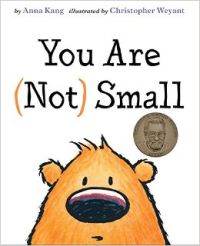 YOU ARE NOT SMALL, by Anna Kang and Christopher Weyant (Ages 2-6)
YOU ARE NOT SMALL, by Anna Kang and Christopher Weyant (Ages 2-6)
A larger bear exclaims to a smaller bear: You are small. The little bear retorts: “I am not small. You are big.” The argument builds between the two, who are similar in appearance except for size and color (one is blue and the other orange), and they resort to calling in their identical friends for comparison. Who is small and who is big? That depends on whom you ask. With simple, sparse text and bold, clean illustrations, this amusing book about size comparison also offers a clever introduction to perspective-taking. --Horning
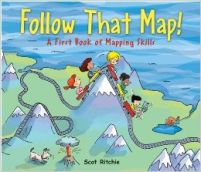 FOLLOW THAT MAP! A FIRST BOOK OF MAPPING SKILLS, by Scot Ritchie (Ages 3-5)
FOLLOW THAT MAP! A FIRST BOOK OF MAPPING SKILLS, by Scot Ritchie (Ages 3-5)
Ritchie cleverly introduces various kinds of maps by incorporating them into a hunt for two runaway pets. Each page invites the reader to interact with the map in a specific way. Younger kids can follow along in the search for the pets, and older readers can appreciate and learn from the map vocabulary. Because the maps resemble bird's-eye views rather than cartographic maps, there is a lot of action to observe in each of them. --Dillemuth
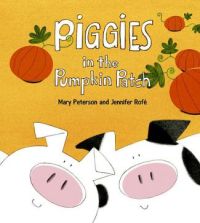 PIGGIES IN THE PUMPKIN PATCH, by Mary Peterson and Jennifer Rofe (Ages 3-7)
PIGGIES IN THE PUMPKIN PATCH, by Mary Peterson and Jennifer Rofe (Ages 3-7)
This playful book includes lots of spatial language as the piggies sneak out of the pumpkin patch and run around the farm. It’s a great introduction to spatial prepositions such as through, into and back. The placement of the text on the page mirrors the meaning of the words. For example, the words “along winding wagon tracks” curve around on the page. --Dillemuth
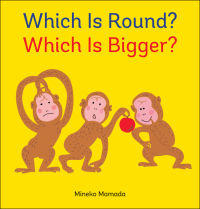 WHICH IS ROUND? WHICH IS BIGGER? by Mineko Marmada (Ages 3-7)
WHICH IS ROUND? WHICH IS BIGGER? by Mineko Marmada (Ages 3-7)
“Which one is round?” The opening page spread poses this seemingly simple question about a round red apple and a long-nosed anteater. The answer is obvious. But with a turn of the page, the apple has been eaten and all that's left is the hourglass shape of the core, while the anteater is now curled up into a tight ball, asleep. "Which one is round? What do you think?" The rest of the book asks additional questions about a series of different pairings. Every time, a turn of the page repeats the original question about the pair, but transforms the appearance of one or both subjects, inviting children to consider more than one answer and to articulate the reasons behind their own response. --Horning
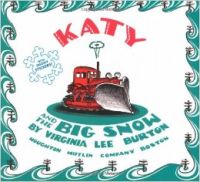 KATY AND THE BIG SNOW, by Virginia Lee Burton (Ages 4-7)
KATY AND THE BIG SNOW, by Virginia Lee Burton (Ages 4-7)
First published in 1943, this classic with a modern feel opens with an amazing map of “Geoppolis,” which we revisit bit by bit when the town is snowed in and Katy must plow out the various sections of town. The book incorporates cardinal directions and offers readers a neat opportunity to think about the spatial relationships of various city services as Katy figures out how to get where she needs to go next. --Dillemuth
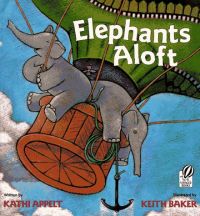 ELEPHANTS ALOFT, by Kathi Appelt (Ages 4-7)
ELEPHANTS ALOFT, by Kathi Appelt (Ages 4-7)
With one word per page spread, the only text in this story is spatial language. Appelt uses positional words that take us on a journey with the elephants in the hot-air balloon. Picture books that have very few words prompt the adult reader to discuss what’s going on in the story with children, and this book’s discussion will touch on a lot of spatial themes. --Dillemuth
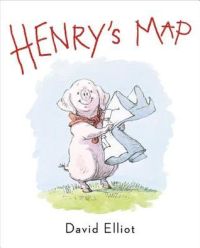 HENRY’S MAP, by David Elliot (Ages 4-8)
HENRY’S MAP, by David Elliot (Ages 4-8)
Henry, a hyperorganized pig, makes a map of the farm to ensure everything is in the right place. This entertaining story introduces the concept of drawing objects in spatial relation to one another. It helps kids understand that a map is a tool to know where things are located and makes the concept of drawing a mapping accessible for young kids. --Dillemuth
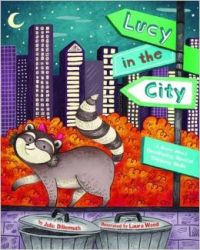 LUCY IN THE CITY: A STORY ABOUT DEVELOPING SPATIAL THINKING SKILLS, by Julie Dillemuth (Ages 4-8)
LUCY IN THE CITY: A STORY ABOUT DEVELOPING SPATIAL THINKING SKILLS, by Julie Dillemuth (Ages 4-8)
This book follows a little lost racoon trying to find her way home. The story introduces readers to three fundamental mapping concepts: interpreting a bird’s-eye view map, paying attention to one’s surroundings and retracing one’s steps as a navigation strategy. Kids trace Lucy’s journey as they look down on the city from the owl’s perspective, counting the blocks as the owl gives Lucy directions. A “Note to Parents, Caregivers, and Professionals” at the back of the book ties the story content to specific types of spatial thinking and offers additional activities to support spatial reasoning.
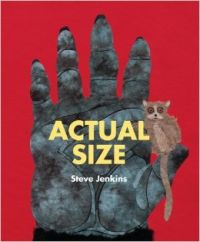 ACTUAL SIZE, Steve Jenkins. (Ages 4-9)
ACTUAL SIZE, Steve Jenkins. (Ages 4-9)
Steve Jenkins always produces engaging, artful science books for children in early elementary school. "Actual Size" presents his trademark cut-paper animals, each accompanied by a pithy line of text. The difference here is the scale: Everything appears at actual size. Jenkins' master stroke, though, is his inclusion of creatures both great and small, so while petite critters fit comfortably within 12-by-20-inch spreads, larger ones appear as evocatively cropped bits and pieces: a gorilla's massive hand; a Siberian tiger's snarling mug; the unnerving, basketball-size eye of a giant squid. The resulting juxtapositions will leave children marveling at one species' daintiness, then shuddering as they mentally sketch in the unseen portions of more formidable beasts. Every child will want to put his or her own hand atop the gorilla’s hand, just for the sake of comparison. --Horning
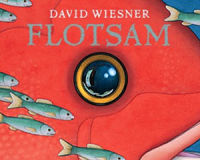 FLOTSAM, by David Wiesner (Ages 5-9)
FLOTSAM, by David Wiesner (Ages 5-9)
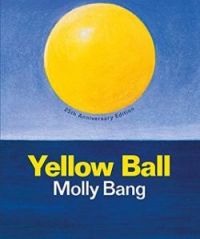 YELLOW BALL, by Molly Bang (Ages 1-3)
YELLOW BALL, by Molly Bang (Ages 1-3)


 UP, DOWN, AND AROUND,
UP, DOWN, AND AROUND, ROSIE’S WALK,
ROSIE’S WALK, SHRINKING MOUSE,
SHRINKING MOUSE, BIG BUG,
BIG BUG, YOU ARE NOT SMALL,
YOU ARE NOT SMALL,  FOLLOW THAT MAP! A FIRST BOOK OF MAPPING SKILLS
FOLLOW THAT MAP! A FIRST BOOK OF MAPPING SKILLS PIGGIES IN THE PUMPKIN PATCH
PIGGIES IN THE PUMPKIN PATCH WHICH IS ROUND? WHICH IS BIGGER?
WHICH IS ROUND? WHICH IS BIGGER? KATY AND THE BIG SNOW
KATY AND THE BIG SNOW ELEPHANTS ALOFT,
ELEPHANTS ALOFT, HENRY’S MAP
HENRY’S MAP LUCY IN THE CITY: A STORY ABOUT DEVELOPING SPATIAL THINKING SKILLS
LUCY IN THE CITY: A STORY ABOUT DEVELOPING SPATIAL THINKING SKILLS ACTUAL SIZE
ACTUAL SIZE FLOTSAM
FLOTSAM